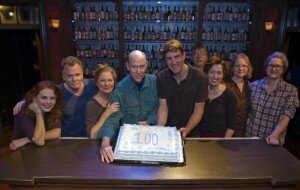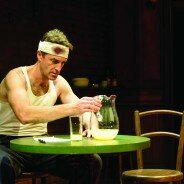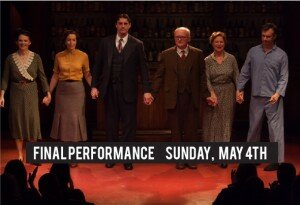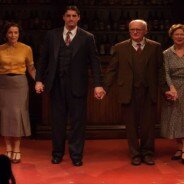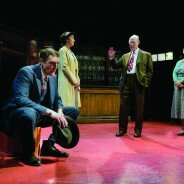Samuel Shem and Janet Surrey
www.samuelshem.com
Gratitude!
Thank you!
We are very grateful to all the people, more than 30 thousand, that attended our production of Bill W. and Dr. Bob. It has been an amazing experience.
Also, we are grateful to our cast and crew!

We were the living example of ’Yale to Jail”. We had audience members who had never been to a live production before – thanks to our “Ticket Sponsor Program”. We also had members of New York City’s first family, Mayor Bill de Blasio, his wife Chirlane McCray, and their daughter Chiara pose with the cast of the Off-Broadway play BILL W. AND DR. BOB (at the Soho Playhouse – 15 Vandam Street) after seeing the performance on Thursday, March 27th, 2014.
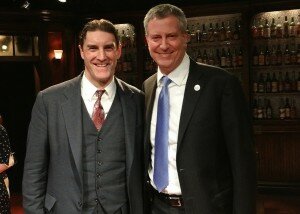
“Bill Wilson meets Bill de Blasio.” On Thursday, March 27th New York City Mayor Bill de Blasio (pictured right) stopped by to see another famous Bill – in the Off-Broadway, hit play BILL W. AND DR. BOB at the Soho Playhouse (15 Vandam Street, Manhattan), picutred here on the left of his honor is actor Patrick Boll, who portrays “Bill Wilson” (one of the founders of AA) in the play. Photo Credit: Dale Heller.
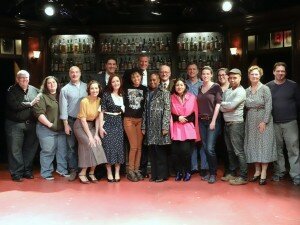
The de Blasio family poses with the cast and crew of the Off-Broadway play BILL W. AND DR. BOB (at the Soho Playhouse – 15 Vandam Street) after seeing the performance on Thursday, March 27th. Photo Credit: Dale Heller.
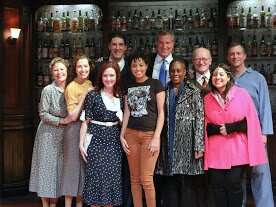
Members of New York City’s first family – the de Blasio’s – - Bill de Blasio, wife Chirlane McCray, children Dante, and Chiara – pose with the cast of the Off-Broadway play BILL W. AND DR. BOB (at the Soho Playhouse – 15 Vandam Street) after seeing the performance on Thursday, March 27th. Photo Credit: Dale Heller.
BARRON LERNER ARTICLE ON NEW YORK TIMES’ WEBSITE
Here is some great news, on Friday February 13th there was a fantastic article posted on the New York Times’ website about the show. It was written by Barron H. Lerner, professor of medicine and population health at the New York University School of Medicine, and the author of the forthcoming book “The Good Doctor: A Father, a Son and the Evolution of Medical Ethics“. Check it out:
READ ON NEW YORK TIMES WEBSITE:
Alcoholism Through a Doctor’s Eyes
By Barron Lerner
When I teach medical students about alcoholism, it is never easy. Students arrive with preconceived notions and stereotypes obtained from books, television and films — and their personal upbringings — about the subject.
So I am especially glad that medical, nursing and other graduate students from my institution, New York University, have been attending the play “Bill W. and Dr. Bob” as part of their studies. The drama, about the founding of Alcoholics Anonymous, is a great way to learn how designating something as a disease is only a starting point for understanding the patients who experience it. Yet as I watched the play recently at New York’s Soho Playhouse, I was struck by how little has changed through the years in our beliefs about alcoholism and what we can do about it.
Bill W. and Dr. Bob were Bill Wilson and Dr. Bob Smith, the two alcoholics who started A.A. in the late 1930s. Prior to that time, heavy drinking was largely seen as a moral failing. Organizations like the Women’s Christian Temperance Union promoted the notion that “drunks” and “sots” were sinners too weak to stand up to “demon rum,” beer and other alcoholic beverages. The “treatment” for this condition was to embrace both abstinence and an evangelical Christianity.
With the emergence of the Anti-Saloon League in the 1890s, the focus shifted to legislative control of alcohol, which culminated in 1919 with the Eighteenth Amendment to the Constitution prohibiting the production, sale and transport of “intoxicating” beverages. Although the “Dry’s” had triumphed, their success was limited. By 1933, Americans had turned against Prohibition, which was repealed by the Twenty-First Amendment.
Now able to obtain alcohol freely, heavy drinkers once again began experiencing high rates of liver disease, alcohol withdrawal, delirium tremens and other complications of their pastime.
Attitudes, however, were changing. What if heavy drinking — alcoholism — was not a sin or a sign of weakness but a disease? In 1937, scientists established the Research Council on Problems of Alcohol, which studied alcohol metabolism and drinking behaviors while trying to avoid moral judgments.
But the most notable development in the 1930s was the founding of A.A. As depicted in the play, A.A. resulted from the chance meeting of Bill Wilson, a New York stockbroker, and Dr. Bob Smith, an Akron surgeon in 1935. Both drank heavily and were destroying their marriages and lives. “You want to drink more than you want to live!” Bob’s wife, Anne, screams at him at one point.
Although it did not specifically term alcoholism a disease, A.A. popularized this notion. Bill had heard this language from his doctor. Alcoholism, he explains during the play, is like tuberculosis. Later on, he calls his condition an “alcohol allergy.” The point was that some men — and the disease was originally believed to affect almost entirely men — could simply not drink in moderation. The only solution was abstinence.
What made A.A. unique was its emphasis on alcoholics helping one another stay sober. Bill hopes that he and Bob can create a “chain reaction to reach all the drunks in the world.” As Bob says, “Our service keeps us sober.” There was a religious component to A.A. Five of the original “12 Steps” followed by A.A. members mention God. But “Bill W. and Dr. Bob” largely emphasizes a nondenominational spiritual awakening in which alcoholics admit that they are powerless as the first step to abstinence and recovery.
Of course, calling something a disease did not automatically eliminate the entrenched cultural beliefs about the condition. As with patients who developed lung cancer from smoking or diabetes from being overweight, alcoholics were still often viewed as lazy and merely lacking the willpower to stop an unhealthy habit. On rounds at my hospital, chronic alcoholics who promise future sobriety are generally met with eye-rolling and, at times, derision.
These reactions still occur, even though scientists have recently identified a genetic component to alcoholism. According to theNational Institute on Alcohol Abuse and Alcoholism, there are a series of genes that are responsible for roughly half the risk of someone becoming an alcoholic.
Another facet of alcoholism that remains familiar is the lack of good treatment options. Detoxification and rehabilitation programs are expensive and not that effective. And while new research suggests that drugs can be used to facilitate drinking in moderation, I still refer the vast majority of my alcoholic patients to A.A., just as other doctors did 80 years ago. Yet even A.A.’s ability to maintain ongoing sobriety among its participants is only about 10 percent, although certain populations, with stronger social supports, do better.
Perhaps the greatest virtue of “Bill W. and Dr. Bob” is how it humanizes alcoholics. Both main characters display a wide range of behaviors, ranging from empowered to helpless to angry to remorseful. It is hard not to sympathize with them. Anne and Bill’s wife, Lois, realize that they, too, belong to a community of sufferers. They founded Al-Anon in 1951 to assist the spouses and families of alcoholics.
“Take the cotton out of your ears and put it in your mouth,” is an expression used by A.A. members to get recalcitrant alcoholics to keep quiet and listen to their brethren. It is good advice.
READ ON NEW YORK TIMES WEBSITE:
http://well.blogs.nytimes.com/2014/02/13/alcoholism-through-a-doctors-eyes/?_php=true&_type=blogs&_php=true&_type=blogs&_r=1&
Barron H. Lerner, professor of medicine and population health at the New York University School of Medicine, is the author of the forthcoming book “The Good Doctor: A Father, a Son and the Evolution of Medical Ethics.”
THE DRUNK DOCTOR AND THE DRUNK STOCKBROKER
By SAMUEL SHEM, Co-author, M.D. D.Phil (Oxon)
Phillip Seymour Hoffman, the brilliant actor, died from a drug overdose. This is a great tragedy. The outpouring of sorrow and tribute has just begun. Online there is a great deal of death about how his death is a lack of willpower. This shows a basic and remarkable misunderstanding of what addiction is. It is not a lack of will, it is a disease. As doctors who have treated many hundreds of alcoholics and addicts, we have come to understand that no amount of willpower can keep an addict or a drunk away from his or her drug of choice. Recovery is not about will-power. It is about venturing out of the isolation of a willful self into a healing connection with other alcoholics or addicts.
Almost eighty years ago two men, Bill Wilson, an alcoholic, and Dr. Bob Smith, “dually” addicted to both alcohol and barbiturates, faced into the lonely hell of addiction, and realized that trying to will yourself through is deadly, and that connection heals. All of the elements of Phillip Hoffman’s tragic journey are in this very first story of finding a treatment for alcoholism: two men on the edge of death, the sudden realization that it was not a “moral failing” but a disease, finding a treatment together, relapsing, and then finding a solid path to sustaining recovery. Sometimes the stories of these successful recoveries of the healing power of connection get buried in our self-valuing society. The public misconceptions of what these two men discovered—Alcoholics Anonymous–is formidable.
The world seeks out heroes—and, less so, heroines. America, from deToqueville, through Emerson’s “self-reliance”, to the thousands of “self-help” volumes, is a nation that highly values “self.” Our mainstream rewards one person or another, not the quality of the connection between them.
In the case of Alcoholics Anonymous, the press and media continually cite Bill Wilson as that hero, the founder of the original 12-step program that has, arguably, done more than any other treatment to heal alcoholics and other substance abusers. Bill always makes the “fame” lists—from Life magazine’s “100 Greatest Americans of the 20th Century” to, in 2010 on the 75th anniversary of the founding of AA, New York Times columnist David Brooks’ entitling his piece “Bill Wilson’s Gospel” and making no mention of Dr. Bob Smith. Biographies of Bill are evergreen and sometimes excellent; there are no comparable biographies of Bob.
“Dr. Bob” was an Akron surgeon who, with “Bill W.”, in one six-hour chance meeting in 1935 in Akron Ohio, created Alcoholics Anonymous. Partly because of our culture’s focus on “the great man,” and the fact that Bill the sophisticated New York stockbroker lived 20 years longer and was a tireless self-promoter (described as “a man who could talk a dog off a meat wagon”) while Bob was a humble and reserved rectal surgeon treating alcoholics in Akron for free, Bill gets almost all the credit, while Bob is a kind of forgotten man. In 1986 when we began researching material for a play about the relationship between the two men, the information on Bob was sparse. Only in Akron, when we met and made friends with Sue Windows, Dr. Bob’s only daughter, did we begin to understand him. Sue and the other locals were delighted that in the play Bob and Bill would be equals.
Bob’s “drunkologue” was every bit as horrific as Bill’s. In his words, “I used pills and booze every day. I woke up in the morning with the jitters, took a sedative to steady my hands for surgery, started drinking again in the afternoon, needing to get drunk to sleep. Sometimes, in the operating room, I’d be high as a kite. Lucky I haven’t killed somebody.” And his eventual recovery was focused on humble “service”; without pay he treated over 5000 alcoholics at St. Thomas Hospital in Akron. As he put it his one his last talks: “Even now I still think I could probably knock off a couple of scotches, but then I say to myself, ‘Better get back on the job, big boy, better go see some of the drunks on the ward.’ Giving of ourselves, our own effort, strength, and time—it takes practice, you know, to learn that spirit of service.”
Yet AA is not about one man “or” the other. The essence of AA is that it is an “and” program—healing arises in the meeting of the two. This “And Factor” is a powerful part of AA. In Bill’s own words, “I realized that no amount of willpower could keep me away from a drink. The only thing that could keep a drunk sober was telling his story to another drunk.” That’s why we entitled the play Bill W. and Dr. Bob. The fellowship, and the healing power, is in that single “and.” They had tried willpower, and it did not work.
When Bill and Bob met that night, each was facing death, trying to find a way to stay alive. We have come to think that the “other drunk” Bill met that night in Akron had to be a doctor. When Dr. Bob hears Bill say that his own physician in New York, William Silkworth, thought “alcoholic allergy” was “a disease”, Bob lights up and says, “A disease? With signs, symptoms, a course and a progression? Implying what? A treatment?” And so Bob recast their shared search for how to stay alive as finding a treatment, and AA was born.
They discovered that, just as in medical illness itself, in addiction there is a danger in isolation and relying on willpower, and there is a healing in mutual connection.
In fact, current medical research suggests that isolation has detrimental effects on the immune system, and connection may stimulate it—and this has relevance for treatments, such as for melanoma and other cancers.
In addition to finding a way to recover, the two men made other discoveries that changed how medicine is practiced today:
By finding that a patient suffering from a particular disease is helped by meeting with another similar sufferer(s), they started what we now take for granted: same-disease support groups (breast cancer, child abuse, war-trauma, etc).
By realizing that alcoholism is a disease with three elements—physical, psychological, and spiritual, and had to be treated in all three arenas—they discovered the “holistic movement”, currently labeled the “bio-psycho-social” model that is now at the heart of modern medicine. All in 1935, eight decades ago.
And what about God? At the time that the two of them met, neither one had much faith in a traditional religious God. As Bob says: “I was forced to attend church four times a week. I vowed when I was free I would never darken the door of a church again—a vow I’ve kept, religiously, for forty odd years.” Bill, too, had more or less given up on God. Both men had pragmatic reasons: they had tried prayer to God, and it didn’t work to keep them sober. The key to their vision about “God” came from a man named Ebby Thatcher, an old friend of Bill’s who said, “You don’t have to believe in God, you just have to admit that you’re not God. Use what you do believe in, whatever it is.”
The essence of this is twofold. If an alcoholic cannot himself stay sober, then asking for help from someone or something outside that “self” is, pragmatically, necessary. One term that is used is “a Higher Power,” or “a Power greater than myself”—whatever form that takes for each person. Second, there is often confusion in the difference between a “religious” program and a “spiritual” program. It is clear from both of these men’s lives that AA is not “religious,” but “spiritual.” Bill’s transformation in Towne’s Hospital three months before he chanced to meet Bob has been described by many writers as a “conversion experience,” a spiritual experience described by William James, a philosopher that both Bill and Bob read. The 12 Steps of AA are heavily influenced by a non-theistic spirituality, Buddhism—in tune with “non-self”, “non-attachment”, “letting go”, which both men, to different extents, embraced. The phrase written into the 12 Steps by Bill and Bob is, “God, as we understood him.” (italics from 12 Steps). Including the word “God” was a way of compromising with various factions at the time, the late 1930’s, a very different era from ours.
Our pundits and columnists will continue to tout the lone hero who prescribes—and sometimes proscribes—to millions. But the healing, not just of the millions of recovering alcoholics and addicts in `12 Step programs, but the hope for healing of the world, lies beyond the hero. The adversarial stance of “I”/”You”, “Either”/”Or”, dominates American culture, from what we drink or drug or eat, to whom we see as enemies. The promise is in shifting from the individual’s will to the quality of the relationship, to that “And”, to a fellowship of mutual healing.
The suffering in AA is centered on “alcohol,” but that particular story is relevant to any human suffering. If we isolate ourselves, and try to will ourselves to walk through our suffering alone, we will suffer more, and we will spread more suffering around. If we try to walk through suffering with others—at best, others with similar sufferings—we will suffer less, spread less suffering around, and walk out of it, perhaps, with a bit more compassion, and even gratitude, and service to others.
Phillip Seymour Hoffman did his best to find this path, and for decades of marvelous sober work did walk it to the limit of his spirit, but then, tipped over by prescribed pain-killers, he relapsed, and died alone. To frame this as a lack of willpower is to diminish not only him, but all those who are in recovery.
Samuel Shem, author of The House of God, and Janet Surrey are the authors of the Off Broadway play Bill W. and Dr. Bob, currently at the Soho Playhouse. (see attached resumes)
SAMUEL SHEM, Co-author, M.D. D.Phil (Oxon)
Samuel Shem, pen-name of Stephen Bergman, is a doctor, novelist, playwright and activist. A Rhodes scholar, he was on the faculty of Harvard Medical School for three decades. Shem has been described in the press as “Easily the finest and most important writer ever to focus on the lives of doctors and the world of medicine”, and “He brings mercy to the practice of medicine.” The Lancet called THE HOUSE OF GOD: ”One of the two most significant medical novels of the 20th century”. Its sequel, MOUNT MISERY, reviewed as “another medical classic,” is about training to be a psychiatrist; FINE is about a psychoanalyst.
His 2008 novel, THE SPIRIT OF THE PLACE, about a primary care doctor in a small town, was reviewed as ”The perfect bookend to THE HOUSE OF GOD”. It won the “National Best Book Award 2008 in General Fiction and Literature” from USA Book News, and the “Independent Publishers National Book Award in Literary Fiction 2009.”
As a playwright, with his wife Janet Surrey he wrote the Off Broadway hit play BILL W. AND DR. BOB, about the founding of Alcoholics Anonymous, which won the “Performing Arts Award of the National Council on Alcoholism 2007”, and is being produced all over the country. He was playwright-in-residence at the Boston Shakespeare Company; and has had many other plays produced, including “The Shem Plays” Off Off Broadway, which were published in THE BEST SHORT PLAYS anthologies. Bill W. and Dr. Bob is now in its 7th month of a run (175 performances) at the Soho Playhouse, Off Broadway.
With Janet Surrey he has also published the nonfiction book: WE HAVE TO TALK: HEALING DIALOGUES BETWEEN WOMEN AND MEN, winner of the Boston Interfaith Council’s Paradigm Shift Award, 1999.
Our Vision
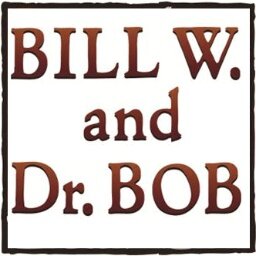 BILL W. AND DR. BOB this weekend hit its 6 month, 150th performance, It seems that this makes it the longest running non-musical/comedy Off Broadway. But it hasn’t been easy.
BILL W. AND DR. BOB this weekend hit its 6 month, 150th performance, It seems that this makes it the longest running non-musical/comedy Off Broadway. But it hasn’t been easy.
When the Off Broadway show closed on June 10, 2007 after a 4-month run, I turned to Janet and said, “Someday we’ll bring it back to Off Broadway the way we dreamed of.” The 2007 show was a commercial venture, with a huge amount of money raised from investors, and huge expenses, in a 350-seat theatre. When summer came, the investors closed it down.
For 6 years it traveled around the country and parts of the world, to 40 states, often to sold-out houses and record-breaking runs—because in addition to the normal theatre audience it attracted those in recovery.
Now we have fulfilled that dream. It is in a small intimate theatre. There are no investors in this production. It is funded entirely by tax-exempt donations to Hazelden Treatment Center Foundation. All proceeds go to a national college and med school tour to deal with the epidemic of binge drinking on campus. I bet that if we had again done it with investors, they might have closed us down after a few weeks. Because no money is being made, we have enough money to keep running. And this time around our mission is not profit, but doing service to the recovery community–as Dr. Bob says: “Service—giving of ourselves—keeps us sober.”
As reviews and those of you who have seen the show have written on Facebook etc, it is a gem—the best production we’ve seen in our 27 years with this play.
But it is not easy. The first crisis was with ticket sales that were below expectations. We tried everything, and I found myself obsessed with numbers, and dollars, and how to increase them. I was getting hard to live with—and had two minor car accidents, and Janet tripped on one of our dogs and almost broke her hip. We were not doing well.
And then I managed to raise enough donations to keep us going for several months. I thought I was through with the crisis.
But one day I got a call from the stage manager, saying that the actors were upset that their dear play was being performed to small audiences on Tuesdays and Wednesdays. A few of them were thinking of not continuing. As I said to Janet: “Oops. Guess what? To do a play you need not just money, but actors.” We called an emergency company meeting, and cut those two days. But we still, on some performances, had a number of vacant seats in the 187-seat Soho Playhouse. What to do?
I called up a woman at a New York City Community Recovery Canter in Brooklyn/Bronx. She had brought a group of 30 to a performance in July, and it was a spectacular, responsive audience. Many of them had never been at a live theatre event before. I asked the woman if she might want to bring another group, for reduced-price tickets like the first time.
“No, our funding is cut. We have no money for that at all.”
And here’s the moment of clarity: I heard a little voice inside say, “You’re not doing this to sell tickets, you’re doing it to do service.”
“Well then,” I said, “if I gave you 45 free tickets for two performances next week, could you bring people?”
“I can fill those seats tomorrow.”
And that started a turnabout in how we can fulfill our mission—to Celebrate Recovery, Educate the public, and Outreach to those in recovery and their families and friends
Janet and I as co-producers decided that we would give away 45 free ticket (25% of our seats) at every performance to those who cannot afford the price of a ticket. . We have a network of people who every week, call their community members or those at their meetings, and offer free tickets. It just takes a call to the box office to reserve them.
These are the greatest, most responsive audiences we have! We have people with no money sitting next to people in the most expensive seats. Both of them laugh hard, fall into silence the same places, shed tears, and, at the end of the show, rise to their feet in a standing ovation—and walk out inspired. It’s that kind of show. More than a good show—a show that goes good.
And you know what? The people in the free seats seem to be the ones that, more often than not, put some spare change or even a dollar bill into the “Donation Box” in the lobby.
This is our vision.
Thank you!
Samuel Shem
AN INCANDESCENT EXPERIENCE
As the first big storm hit New York City last Saturday, Janet my wife and co-author were on our way to see the matinee performance of BILL W. AND DR. BOB. We live in Massachusetts. So we had not seen the show for about a month. We traveled on the fast train from Boston very early and arrived to a blustery snow covered city around Noon. We were hoping the snow would just be a dusting, we were wrong. It was the first big snow storm of the season. We did not know what type of show to expect with this kind of weather. Will people come? Will it be a small crowd? Will those that do show up be too cold and wet to engage and enjoy our show? Turns out,,they did show up. One man visiting from Australia came in and bought a ticket. We chatted with him as he marveled at the snow. It was at that moment I knew it would be OK. I let go. Soon after, a couple from New Jersey came in, they drove in early to make sure we were going on with the show. They had bought tickets a month ago. Little by little groups of people arrived, from The Bronx; from Connecticut; most covered in snow, all excited they made it to the theater. They all warmed up, drank warm beverages downstairs at the coffee bar before the show started. We had a pack house that afternoon.
The audience was a dream audience: a total mixture of cultures, ethnicity, races, ages, education and other differences. Because we have a policy of giving away 45 free tickets to every performance to those in recovery communities who can’t afford the price of a ticket, there were many people who have rarely, if ever, been to a live drama. There were also obvious “theatre buffs,” and everyone in between. And how many were in 12 step programs? Well, from the first line–“My line is Bill W. and I’m an alcoholic”—we can tell, from the power of the responses of the audience, “Hi Bill!” approximately how many are in recovery. There were a lot that day.
The miracle of live theatre is the same as the miracle that Bill Wilson and Dr. Bob discovered: the mutual connection between people, in this case, between audience and actors.
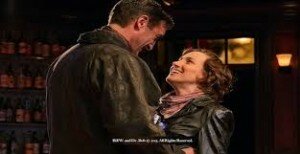 The six-member cast has always been terrific—Broadway actors and less seasoned ones—but this time around, as we watched the show, we realized that after six months and almost 150 performances, the actors had settled into it in an amazing way. Janet and I watched the show as if we had not written it—it was just there. Even more amazing, it was as if they were no longer “acting” it—it was just happening. The humor had the crowd in stitches, the drama had them on the edges of their seats, and the sadness and, at the end, the triumph of this astonishing true story that has helped millions, had them sniffling and in tears, before they rose in a loud standing ovation. During the show there was also a lot of talking back to the actors—“No no Bill, don’t take that drink!” or “You go girl!” etc. Not the usual restraint of Broadway. Theatre experts have been trying to create “peoples’ theatre,” where everyone will come, and this is it. In the Program they talk about membership that’s “From Yale to Jail.”
The six-member cast has always been terrific—Broadway actors and less seasoned ones—but this time around, as we watched the show, we realized that after six months and almost 150 performances, the actors had settled into it in an amazing way. Janet and I watched the show as if we had not written it—it was just there. Even more amazing, it was as if they were no longer “acting” it—it was just happening. The humor had the crowd in stitches, the drama had them on the edges of their seats, and the sadness and, at the end, the triumph of this astonishing true story that has helped millions, had them sniffling and in tears, before they rose in a loud standing ovation. During the show there was also a lot of talking back to the actors—“No no Bill, don’t take that drink!” or “You go girl!” etc. Not the usual restraint of Broadway. Theatre experts have been trying to create “peoples’ theatre,” where everyone will come, and this is it. In the Program they talk about membership that’s “From Yale to Jail.”
Janet and I, who have seen the show hundreds of times, shared the laughter and tears afresh. We walked out into the blizzard conditions. The incandescence of the show made us feel warm–at least for awhile. One thought intruded: this is our child, a great kid that can help inspire and heal hundreds of thousands, and we felt a little sad that not more people know to come. “Let’s hire a press agent,” I said. “We’ve got to work more on marketing.” Janet said: “Attraction, not promotion. It’s happening already.”
Samuel Shem and Steve Bergman, M.D. Ph.D.
www.samuelshem.com
Gratitude!
DONATE A FREE TICKET FOR THOSE IN RECOVERY WHO CANNOT AFFORD TO PAY.
BECOME A TICKET SPONSOR
We provide 45 Free Tickets Per Performance to those in recovery
communities or treatment centers or other groups who cannot afford to buy tickets.
Our last performance is May 4th, 2014.
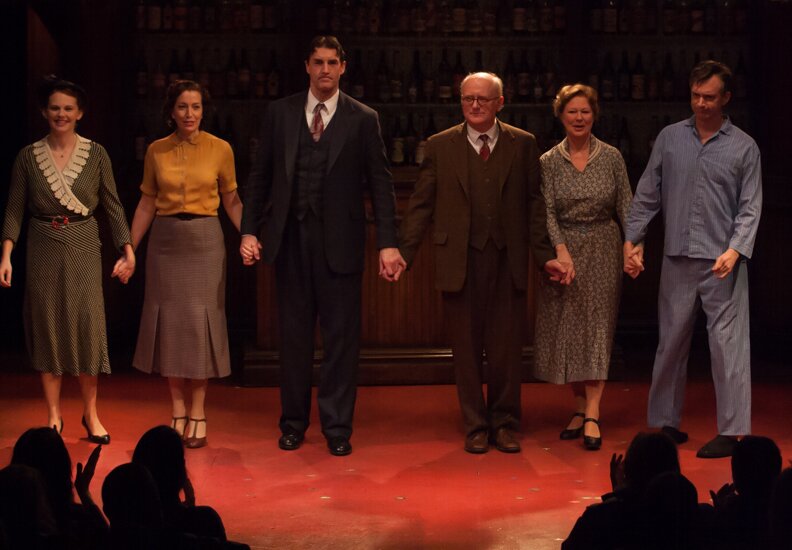
P.S. “Our service keeps us sober”—Dr. Bob Smith
ANY LEVEL OF DONATION IS WELCOME.
1 Ticket – $22 2 Tickets $44
4 Tickets $88 6 Tickets – $132
10 Tickets – $220
To sponsor one performance: (45 tickets at $22): $990
To sponsor one week (5 performances): $4950
To sponsor one month (4 weeks): $19,800.
THERE ARE 2 WAYS TO DONATE
WRITE CHECK OR PAYPAL
CLICK BUTTON FOR PAYPAL
WRITE A CHECK
Make check payable to Cinnamon Ventures
“BILL AND BOB PLAY” (in MEMO)
Send to Soho Playhouse, Attn: Ticket Program
15 Vandam St. NY, NY 10013
Phone: 212-691-1555
BILL W. AND DR. BOB, our award-winning Off Broadway play now at the Soho Playhouse, is celebrating 9 months.
In return for this sponsorship, your name will be noted in the theater as the sponsor of that particular night, week, or month.
You can, of course, remain anonymous.
LAST CHANCE! ONLY 5 PERFORMANCES TILL SHOW CLOSES!
LAST SHOW MAY 4TH
DON’T MISS YOUR CHANCE TO SEE OUR SHOW!
SHOW DAYS & TIMES
LAST WEEK!
May 1st 7 PM
May 2nd 8:30 PM
May 3rd 3:00 PM
May 3rd 8:30 PM
May 4th 3:00 PM
Sponsorship!
BILL W. AND DR. BOB, our award-winning Off Broadway play, closed after 11 months on May 4th.
Our successful run at the Soho Playhouse ended after more than 250 shows, and seating over 30 thousand people.
We are so proud.
Although the New York Off-Broadway production has closed, you can still be involved.
You can donate to future productions.
We are hoping to bring the international tour.
In return for this sponsorship, your name will be noted in the playbill.
You can, of course, remain anonymous.
CONTACT US BY EMAIL: [email protected]
THERE ARE 2 WAYS TO DONATE
WRITE CHECK OR PAYPAL
CLICK BUTTON FOR PAYPAL
To DONATE:
WRITE A CHECK
Make check payable to Cinnamon Ventures
“BILL AND BOB PLAY” (in MEMO)
Send to: Cinnamon Ventures, Attn: Sponsorship
75 Bellevue Street
Newton , MA 02458
Discounts and Events
Discounts, Schedule, Special Offers and Events! Click here for more information:



